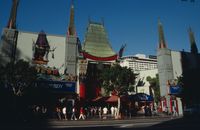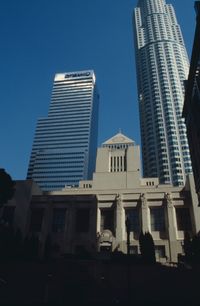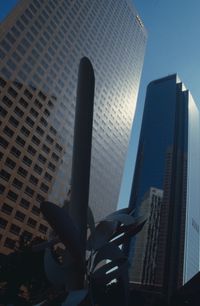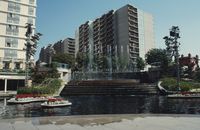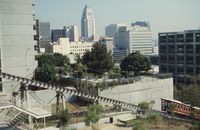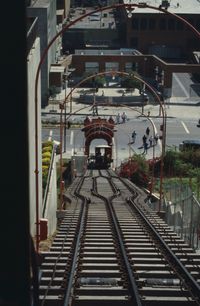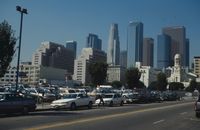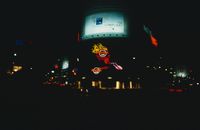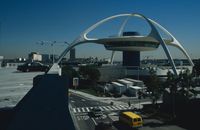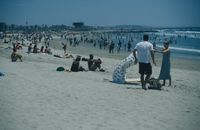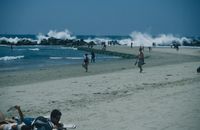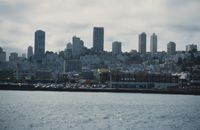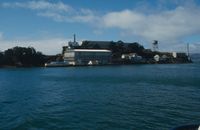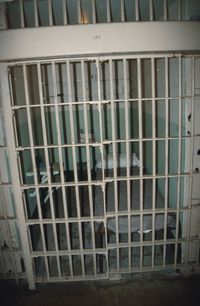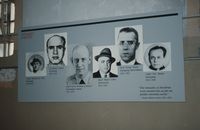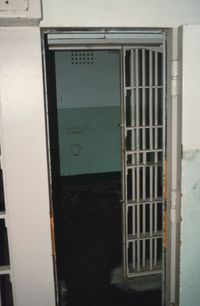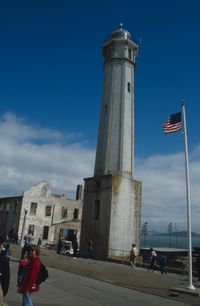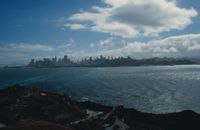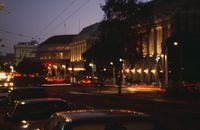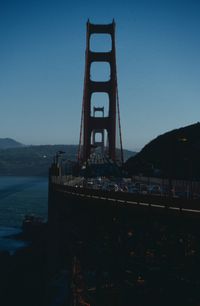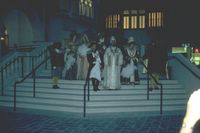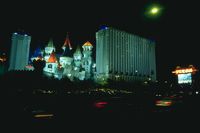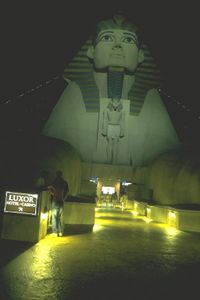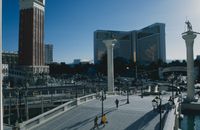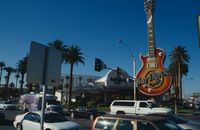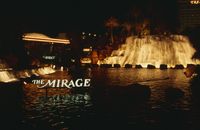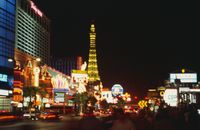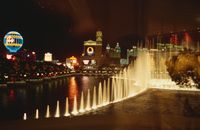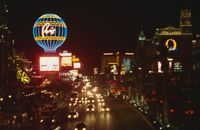Besuchte Städte
Los Angeles
Tja was kann über Los Angeles gesagt werden. ein wahrlich faszinierende Stadt die viele Gesichter trägt. Ich konnte mir selber in den 9 Monaten ein Bild von der Stadt machen und ich bin zu dem Schluss gekommen, dass LA nicht meine Traumstadt ist. Gründe hierzu gibt es viele, zum einen ist LA eine reine Autostadt in der die Autobahnen 4 oder 5 spurig ausgebaut sind und die öffentlichen Verkehrsmittel nur von ärmsten Leuten benutzt, was sie nicht gerade sicher macht und zum anderen ist die Stadt abseits von den Glamour und Vorzeigevierteln wie Beverly Hills oder Downtown LA sehr dreckig und es kümmert keinen, wie dreckig die Wohngegenden aussehen. La ist eine Stadt, die den multikulturellen Ansprüchen gerecht wird und wie gemacht für die Feiern der Filmstars ist. Filmpreise werden in LA genauso übergeben wie Filmpremieren gefeiert und die Schauspieler sich zum besten geben. Aber im täglichen Leben sind die Stras genauso Mensch wie jeder andere auch, und mit etwas Glück kann der eine oder andere Star schon mal beim Einkaufen erwischt werden.
Santa Monica, Venice Beach, Hollywood, Beverly Hills, Universal Studios, Disneyland, und und und, es gibt soviele Sehenswürdigkeiten in Los Angeles, dass sich auf alle Fälle ein Urlaub hier lohnt und in den Sommermonaten ist es an der Beach umso schöner, nicht nur wegen der Strandschönheiten, sondern auch wegen der Beach Promenade.
Wer sich für die Geschichte von Los Angeles interessiert, der sollte auf folgende Homepage gehen: Los Angeles Timeline.
The new governor of California, Felip de Neve, recommended to the viceroy in Mexico that the place suggested by Father Crespi as an ideal place for a mission be developed into a pueblo. King Carlos III of Spain in turn took the recommendation and ordered Governor de Neve to establish the pueblo. De Neve took the job of establishing the settlement very seriously. He drew up plans for the pueblo, including a plaza, fields, pastures, and royal lands. This surely is the first time a city has been planned before the first settler arrived, and ironic in view of the unfettered growth of Los Angeles. By 1790 Los Angeles had 28 households and a population of 139. By 1800 the population was 70 households and a population of 315. There were also a town hall, guardhouse, army barracks, and granaries. This Spanish town neither knew nor cared that the United States had been born and was already moving relentlessly across the continent. The first Yankee settler did not arrive until about 1820.
SAN FRANSISCO
Im Vergleich zu anderen amerikanischen Grossstädten ist San Fransisco recht klein. Die Strassen verlaufen im allgemeinen senkrecht bzw. parallel zueinander. Die interessantesten Punkte der Stadt sind leicht zu Fuss oder mit öffentlichen Verkehrsmitteln zu erreichen. Als Startpunkt für Spaziergänge bietet sich in DownTown der Union Square an. Mit je einen halben Tag kann die Stadt in Ruhe angesehen werden und viele Sehenswürdigkeiten wie China Town, Fisherman's Wharf, Alcatraz, Soma, Golden Gate Park, North Beach etc. besichtigt werden.
In San Fransisco ist jeder 4. Einwohner fernöstlicher Herkunft. Somit ist die Stadt dazu bestimmt, asiatische Hauptstadt Amerikas zu werden. Die nahe gelegenen Universitäten Berkeley und Stanford und das Silicon Valley, das sich damit brüstet, die grösste Anzahl hochintelligenter Gehirne pro Quadratkilometer zu haben, führten dazu, dass sich San Fransisco zu einem der Hauptzentren der Intellektuellen des Landes entwickelte. Um das eigene intellektuelle und kulturelle Erbe zu verteidigen, akzeptieren die San Fransiscaner eher, einem Exodus ehrgeiziger Kapitalisten zuzusehen, als die Lebensfreude der Metropole aufzugeben. Der strenge Stadtbauplan begrenzt die Höhe der Wolkenkratzer je nach Stadtviertel. Dadurch hat San Fransisco ihren einzigartigen, unverkennbaren Charakter beibehalten können und ist mehr als nur eine Stadt, sie ist eine "Lebensart".
Visually spectacular, historically colorful, and a regular trendsetter in everything from flower power to gay liberation. San Francisco consistently tops the polls as America's favorite city. The City's irresistible attraction starts with the way it looks, Streets soar up and plunge down the steep hills, framing spectacular views and hiding quiet little pockets within the urban chaos. In the background there's always the Bay, crossed by not one but two of the world best known bridges. What's more, San Francisco is a city of multiple disguises; sure there's a booming downtown business center, but there are also a lot of micro cities. San Francisco's colorful, crowded, and frenetic Chinatown jostle up against ritzy Union Square, and quickly fades to the bars, cafes, and restaurants of North Beach, the Beat center of the '50s. that blend into Fisherman's Wharf, the raucous tourist center and jumping-off point for Alcatraz. There's also the Latino enclave of the Mission, the gay epicenter of the Castro, the club scene in SoMa, reminders of the flower power era in the Haight-Ashbury, and the much-loved Golden Gate Park.
The city of San Francisco is a compact area, covering the tip of a 30-mile-long peninsula with the Pacific Ocean on one side and the San Francisco Bay on the other side. The city can be nearly divided into three sections. the central part resembles a slice of pie, with Van Ness Ave and Market Street making the two sides and the Embarcadero the rounded edge of the pie. Squeezed into the compact slice are the Union Square area, the Financial District, the Civic Center area, Chinatown, North Beach, Bob Hills, Russian Hill, and Fisherman's Wharf.
The Transamerica Pyramid and the Golden Gate Bridge make fine city symbols but San Francisco has another much older icon, the beloved Cable Car. Cable cars were conceived by English mining engineer Andrew Hallidie as a replacement for the horse-driven trams that found the city steep streets difficult and dangerous. San Francisco may have saved the system from politicians and accountants but saving it from old age became a new problem as derailments and runaways became increasingly frequent occurrences. In 1979, a six-month shutdown for a million dollar' worth of repair was just a Band-aid solution and in 1982 the system was finally closed for a $60 million complete overhaul. the rebuilt system, which reopened in 1984, consists of 40 cars on three lines covering a total of 12 miles. that may be a pale shadow of its heyday but the cable cars are a enormously popular tourist attraction and much loved be San Franciscans.
SAN DIEGO
In San Diego war es nur ein kurzer Besuch, aber Sea World mit den Orka Walen war schon echt der Wahnsinn.
San Diego Country comprises 4200 sq miles, extending about 60 miles between Orange and Riverside Countries to the north, to the Mexican border in the south, and about 79 miles from the Pacific seashore over the coastal mountain range to the deserts of Anza-Borrego. People looking for a laid-back California lifestyle are often disappointed with the pace and pollution of LA, but find what they want in San Diego. San Diego is a pretty easy place to find your way around. The airport, train station, and Greyhound terminal are all in or near the downtown area, which is a compact grid east of San Diego Bay. the main north-south freeway is I-5, which parallels the coast from the Camp Pendleton Marine Corps Base in the north to the Mexican border at San Ysidro.
Famous attractions in San Diego are the Wild Animal Park and the San Diego Zoo. The Zoo and the Wild Animal Park share an active program of breeding endangered species in capacity, for reintroduction into their natural habitats. It has done this with species including Arabian oryx, Bali starling, and California condor. The zoo has also been recognized for its gardens. some plants are now used for the specialized food requirements of particular animals. More recently, the zoo has developed its entertainment and education role, with the opening of the children's zoo exhibit and outdoor theaters for animal shows. Most visitors will have their own favorites, but the koalas are so popular that Australians may be surprised to find them a sort of unofficial symbol of San Diego.
Sea World in San Diego is undoubtedly an popular attraction. It was founded in 1964 and Shamu, its killer whales, has become an unofficial symbol of the city. Sea World is very commercial, but nonetheless entertaining, and even slightly educational. Its popularity can be drawback, with long waits for some shows and exhibits at peak seasons. At 36$ for adults its a pretty expensive day. Discount coupons are available, but extras really add up - parking costs, food, and not so many visitors escape without spending something on the ubiquitous Sea World souvenirs.
SANTA BARBARA
Ach Santa Barbara war echt nur leider eine Durchreise entlang an der Küste zwischen LA und SF.
Sandwiched between the Pacific Ocean and Santa Ynez Mountains, Santa Barbara is often called the California Riviera because of its affluent population, Mediterranean architecture, and seaside location. Five colleges in the area, including the University of California Santa Barbara (UCSC), give the town a youthful vivacity and balance Santa Barbara yacht clubs and retirement communities. The downtown has outstanding architectural integrity, a masterpiece of a courthouse, and noteworthy art and natural history museums. Rising abruptly and majestically to the north, the Santa Ynez foothills offer great hiking and camping opportunities.
Mission Santa Barbara is called the Queen of the Missions and it sits on a majestic perch a half mile north of downtown at the foot of the Santa Ynez Mountains. the Missions was established on December 4, 1786 as the tenth California mission. Unfortunately, its stately exterior is much more impressive than its interior, which has been reconfigured as a museum with glass-in artifacts. the church still has Chumash decorations on its walls, and the garden in the courtyard are peaceful. Behind the church is an extensive cemetery with 4000 Chumash graves and elaborate mausoleums of early California settlers.
LAS VEGAS
as Vegas das Spielerparadies, einmal im Leben sollte jeder diese faszinierende Stadt gesehen und erlebt haben. Entlang des Strips reihen sich die Casinos mit Hotels auf und eines ist größer, verzaubernder, irrealer als das andere, wobei doch alle das gleiche Ziel haben: Einem um sein Geld zu erleichtern. Hotelübernachtungen sind in aller Regel während der Woche billiger und an den Wochenenden teuer. Im Excalibur kostet eine übernachten in einem Einzel Appartment ca. 50$. Für das was die Hotels am Strip alles bieten, sind die Preise noch einigermaen normal, es soll ja das Geld nicht damit verprasst werden, die Übernachtungen zu zahlen sondern das Geld an den Slotmaschines los zu werden. Solange im Casino gespielt wird, sind die Getränke frei, und zwar alle Getränke. Dass sich in den Casino keine einzige Uhr befindet ist ja erklärbar, der Kunde soll ohne Zeitdruck spielen und einmal im Casino angelangt, findet man nur schwerlich wieder den Weg hinaus.
Die Stadt Las Vegas bietet aber neben gambling auch noch eine menge an anderer Attraktionen. Die Lage von LV ist mitten in der Wüste und es können Tagestouren unternommen werden, die dann zu den Red Rock Canyon, zum Hoover Damm oder zum Lake Meat führen. Etwas weiter entfernt sind der Zion National Park, der Bryce Canyon und der Grand Canyon. Eine Stadt mitten in der Wüste, gebaut mit nur einem Ziel: Den Leuten das Gold aus der Tasche zu ziehen. Noch immer werden neue Hotels gebaut, das letzte, im Jahr 1999, fertig gestellte Hotel ist "Paris". Eine "kleine" Kopie des Eiffelturms ziert die Fassade und wie auch am realen Eiffelturm kann mit einem Aufzug hochgefahren werden. Zum jetztigen Zeitpunkt wird schon wieder ein neues Hotel gebaut, es soll den Namen "Aladin" tragen (damals 2000!).
Nun Las Vegas ist eine Stadt, die für eine paar Tage recht gut sein kann, aber für längere Aufenthalte ist diese Stadt wohl nicht geeignet. Manche sagen sogar: man liebt sie oder man hasst sie! Ich für meinen Teil kann nur sagen, die Stadt ist ein Besuch wert.The triangle of southern Nevada is part of the Mojave Desert, which extends into California, northwest Arizona, and southern Utah. The main city is, of course, Las Vegas, a huge, internationally known destination, which everyone should see at least once. Las Vegas is also a good base from which to explore other attractions of the region. Beautiful Red Rock Canyon is just out of town, while the forests and snow fields of Charleston Peak are less than an hour away. Also close are the imposing Hoover Dam, Lake Mead, and the gambling gulch of Laughlin. The brilliant Valley of Fire can be reached in a few hours, as can Death Valley in California. A day's drive brings you to Grand Canyon and the massive Navajo Reservation in Arizona, or to Zion National Park and Bryce Canyon National Park in Utah. Still another options for a quick overview is an air tour.
This is the original "love it or hate it" town. Most people are dazzled be their first sight of the bright lights in Glitter Gulch and the Strip, and staggered by the scale and extravagance of it all, but many are overwhelmed almost instantly by its downright tackiness. If you've come for the gambling and the glitter, you'll love it - at least for a few days, until your money disappears. But to anyone with cultural pretensions, it's tasteless, gaudy, vulgar, commercial, and crass. Las Vegas is a place people love to hate. As a piece of modern America, Las Vegas is truly remarkable. In 90 years it has grown from nothing to nearly a million people. It's the fastest growing city in the nation, with greater recognition than many cities twice its size, and it's the biggest single attraction in the country, receiving nearly 30 million visitors a year. Amazingly, this has been achieved in an isolated location on the middle of the desert, almost entirely devoid of natural advantages. Las Vegas has made an industry of providing the whole country with something it wants: budget-priced glamour for mass consumption and the tantalizing hope of instant wealth. It manages to reach out for a family market, while still pretending to be little bit naughty; titillation is the shock in trade.
